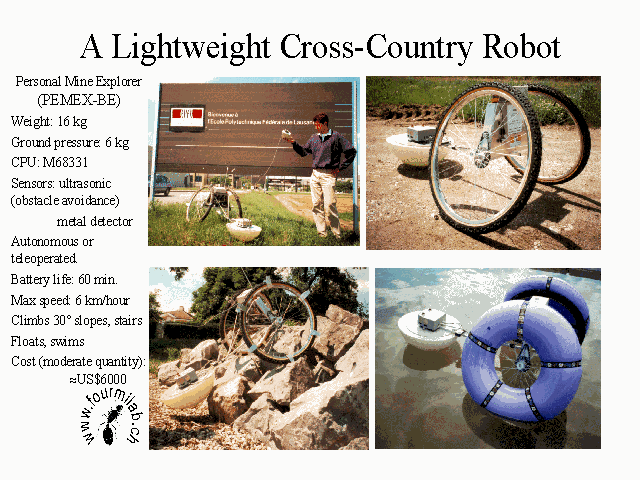

|
|
|
But robots are so cool it's hard to resist the temptation to build one anyway. Most explosive disposal robots, used to search for and disarm terrorist bombs, resemble miniature tanks and cost anywhere from US$60,000 to US$300,000. They are sufficiently heavy to detonate an antipersonnel mine, so they cannot advance into a minefield without absolute confidence the terrain ahead is not mined.
To explore the light-weight, low-cost end of the robot spectrum, the demining project in Lausanne built a series of miniature prototypes and finally a full sized prototype of the Personal Mine Explorer robot. It weighs a total of 16 kilograms and never exerts a force of more than 6 kg on the ground. A lighter production model should be able to exert sufficiently little pressure to avoid triggering any non-defective antipersonnel mine. The robot moves both wheels together to advance and differentially to sweep the sensors in the white dome back and forth over the terrain.
It climbs 30 degree slopes and stairs with the aid of cleats on the wheels and floats and swims with auxiliary water-wings and paddles. Its lead-acid batteries give it an autonomy of about an hour between recharges. Its two Motorola 68331 processors can be programmed in C on a PC. The robot can operate autonomously or be teleoperated by a remote control box.
Six Polaroid and six Sharp ultrasonic transceivers allow obstacle detection and avoidance, and the sensor dome allows experimenting with various sensors in close proximity to the ground.
As is frequently the case with light robots, the cost of the motors dominates, which makes the two-motor design attractive. These robots could be built in moderate quantities for about US$6000, substantially less if large orders allowed optimising the manufacturing process and mass-producing subassemblies.